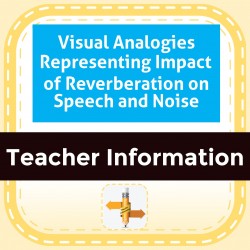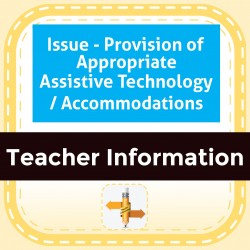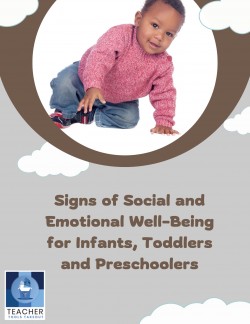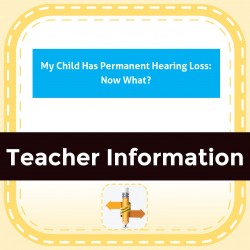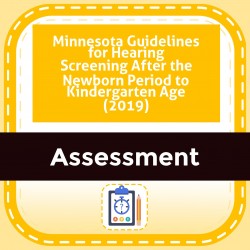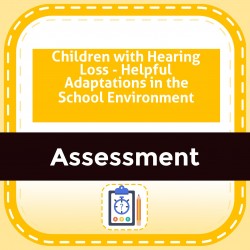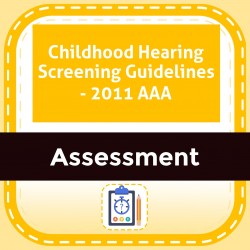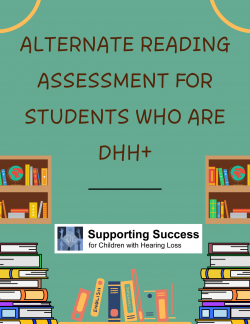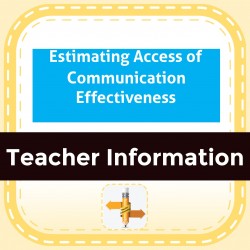Ability Levels
Categories
Resource Types
Age/Grade Range
CCSS
Anchor Standard
Speaking & Listening
Language
Reading
Visual Analogies Representing Impact of Reverberation on Speech and Noise
$ 0
This handout shows 3 popular analogies showing the impact of understanding written sentences in the presence of reverberation and noise and presents speECH- understanding in terms of puzzle pieces. C
...
an also be used as teaching tools to increase student understanding of reverberation and noise effects.
Issue - Provision of Appropriate Assistive Technology Accommodations
$ 0
The information below on provision of assistive tECH-nology has been derived from sections of IDEA and Office of Special Education Program comments. The guidance provided helPS- clarify the intent of
...
IDEA and may be useful to professionals and parents alike who are trying to advocate appropriate services and supports for children with hearing loss.
Signs of Social and Emotional Well-Being for Infants, Toddlers, and Preschoolers
$ 0
This handout lists appropriate behaviors indicating typical development of social-emotional well-being age ranges in months along with recommended actions that a parent or caregiver can take to encour
...
age healthy social-emotional development at each age range. From Center on the Social and Emotional Foundations for Early Learning.
My Child Has Permanent Hearing Loss: Now What?
$ 0
Once a child is diagnosed with hearing loss family members have many questions. This resource provides information addressing how overwhelming the diagnosis can be and families may have many feelings
...
about the testing process and the diagnosis. It describes where you can find help and support and why it is important to start services shortly after the hearing loss is diagnosed.
Minnesota Guidelines for Hearing Screening After the Newborn Period to Kindergarten Age (2019)
$ 0
Minnesota guide to hearing screening for children after newborn age until five years old - including pass/refer criteria, frequency of screening, ideal setting for screening, necessary training, docum
...
entation for hearing screening, and monitoring program quality.
Children with Hearing Loss - Helpful Adaptations in the School Environment
$ 0
Checklist for school teams to use when considering school accommodations for students with hearing loss.
New Teacher Bundle
$ 40
The New Teacher resource is an invaluable bundle packed with information you can use to explain the impact of hearing loss to your student's teachers and parents. 30 pages of resources. The New Teach
...
acher Combo includes:1. Impact of Hearing Loss on Listening, Learning, and Social Interactions (5 pages)2. Emailable, computer fillable SIFTERs (Preschool, Elementary, Secondary) (6 pages)3. Emailable, computer fillable LIFE-R Teacher Appraisal (2 pages)4. Emailable, computer fillable Access to Curriculum Inventory (ATCI) for General Education Teacher (3 pages)5. Children with Hearing Loss Miss More Than You Think (1 page)6. Listening Comprehension Exercise – Mother’s Aprons (1 page)7. Barriers to Listening – Visual analogies of listening in noise, reverberation, and distance (5 pages)8. Student Listening Challenges – Understanding the Missing Pieces (1 page)9. Attitude is Caught, Not Taught (teacher version) (1 page)10. Hearing Aid/Cochlear Implant Monitoring and the Law (1 page)11. Hearing Aid Monitoring – An Important Daily Activity (4 pages)12. Emailable Tips for Teachers (Early Childhood + K-12) Word version (15 pages)
Childhood Hearing Screening Guidelines - 2011 AAA
$ 0
Hearing screening guidelines were compiled in 2011 for the American Academy of Audiology. Guidelines are for students in preschool and K-2,3-5,6-8,9-12 and include specific recommendations for use of
...
puretone, otoacoustic emissions, and tympanometry screening plus recommendations for follow up.
Alternate Reading Assessment for Students who are DHH +
$ 0
Current legal mandates call for all students to reach proficiency as measured through state reading assessments. While reading has long been an area of emphasis in DHH education, meeting this mandate
...
is even more challenging when students with hearing loss have additional disabilities. This article summarizes results of an investigation of alternate reading assessments for students who are DHH+ and offers strategies for moving the needle toward improved assessment data.
Estimating Access of Communication Effectiveness
$ 0
The opportunity to access to all classroom instruction and peer-to-peer communication is a key assumption of regular education and of 504, IDEA and Title II of the Americans with Disabilities Act (ADA
...
). A November 2014 policy guidance from the US Department of Education and US Department of Justice clarified that, under Title II of the ADA, schools are required to ensure that communication for students who are deaf and hard of hearing are as effective as communication for others through the provision of appropriate aids and services, thereby affording an equal opportunity to obtain the same result to gain the same benefit as that provided to others and to participate in and enjoy the benefits of the district’s services, programs, and activities . The ADA requirements restate the principles stated under Section 504, which is often seen as the means used to fulfill the requirements of ADA. Per the U.S. Department of Justice2 : Public entities must not discriminate against, deny the benefits of, or exclude qualified individuals with disabilities from participation in any service, program, or activity. The aids, benefits, and services provided to persons with disabilities must be equal to those provided to others, and must be as effective in affording equal opportunity to obtain the same results, to gain the same benefit, or reach the same level of achievement as those provided to others. These requirements apply to all school-related communication for children with known hearing, vision or expressive speech impairments, ages 3 through 22, who are educated in public schools, including charter and magnet schools
 Your browser is out of date. For best experience switch to latest updated Browser.
Your browser is out of date. For best experience switch to latest updated Browser.
 Get Chrome
Get Chrome Get Edge
Get Edge Get Firefox
Get Firefox